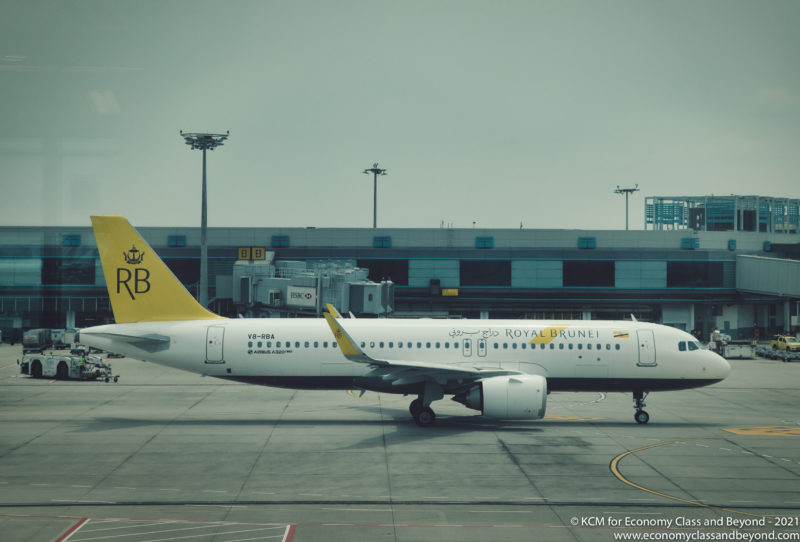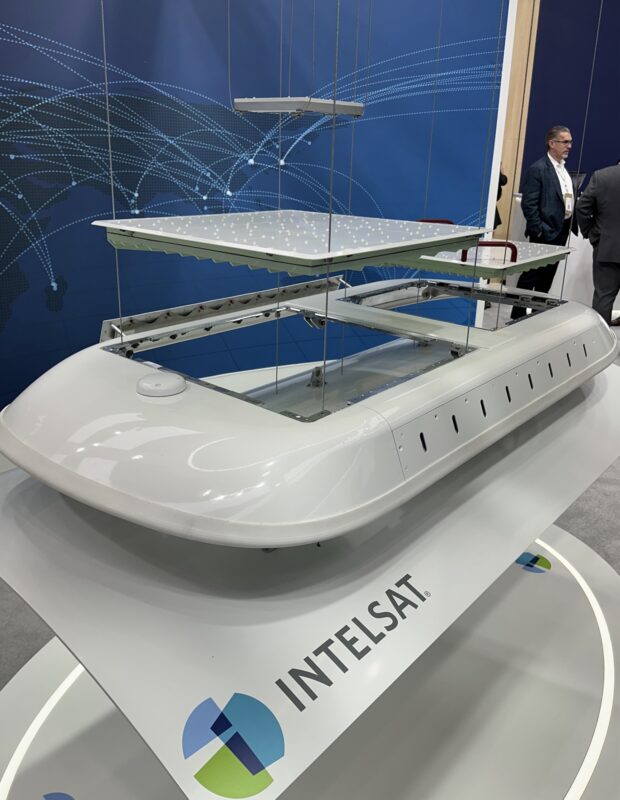Royal Brueni is stepping up its connectivity options, with the airline selecting Intelsat for in-flight connectivity, with a focus on Multi-Orbit connection.

Royal Brunei Airbus A320 at Singapore Changi Airport – Image, Economy Class and Beyond.
The airline has selected the Intelsat network to provide multi-orbit in-flight connectivity service to the airline’s Airbus A320neo fleet.
In the fourth quarter of 2025, Intelsat will start installing the new multi-orbit system on the A320s, including the new electronically steered array (ESA) antenna, which is less than seven centimetres tall and delivers unmatched reliability connecting to both Intelsat’s geostationary (GEO) satellites and low-Earth Orbit (LEO) satellites.
Here’s an exploded view of one, taken at Aircraft Interiors Expo:
From this, you can see the locations of the LEO and GEO antennas, as well as how the antennas sit against an aircraft fuselage.
Royal Brunei provides scheduled services across Asia, the Middle East, Australia, and the United Kingdom, with the A320neos used on regional flights in Asia. This installation will cover the seven A320neo aircraft in its passenger fleet. The airline also operates five Boeing 787-8 for denser and long-haul flights.
In Quotes
Mike DeMarco, Intelsat Chief Commercial Officer, said
“Royal Brunei’s passengers will soon benefit from reliable, multi-orbit connectivity that will provide the same fast and dependable internet access they enjoy at home no matter where or when they fly,”
“The Intelsat team is proud to have been selected by RB to deliver a product that will keep the airline on the cutting edge.”
Captain Sabirin Haji Abdul Hamid, Royal Brueni Chief Executive Officer said:
“We’re excited to bring this next generation of connectivity to our Airbus A320neo fleet, ensuring our guests stay seamlessly connected wherever their journeys take them. This technology not only sets a new standard for in-flight internet, but also reflects our commitment to innovation and delivering an exceptional experience for travelers across the region.
We believe that staying connected in the air is a necessity, and we’re proud to partner with Intelsat in delivering this next-level experience to our travelers across the Asia-Pacific region.”
The Rise of Multi-Orbit Connectivity
With the LEO demonstrations that we saw at Aircraft Interiors Expo this year, the talk has shifted away from just using one orbit to connect and using multi-orbit systems. The idea is that two orbits allow both for coverage as well as bandwidth, with the software being able to switch over as needed, when one network is more constrained.
We’ve seen other airlines adopt this too (with Air Canada using Intelsat’s equipment and American Airlines joining them later in the year), as airlines adjust how they wish to connect in the skies, and what networks work best for them.
Last year, I wrote a primer on LEO, MEO and GEO connectivity – and how it impacts you when you sit in your seat connecting to the internet whilst in-flight.
I’ll have an update to it in a few weeks, as things have moved along a fair bit, as we leave marketing behind and head into the real world.
Disclosure: Economy Class and Beyond was a guest of Intelsat at AIX 2025.
Welcome to Economy Class and Beyond. Your no-nonsense guide to network news, honest reviews, in-depth coverage, unique research, as well as the humour and madness I only know how to deliver.
Our Social Media pool has expanded. You can find us across most networks as @economybeyond on BlueSky, Threads, Mastodon and Instagram!
Also, remember that we are part of the BoardingArea community, bringing you the latest frequent flyer news from around the world.
